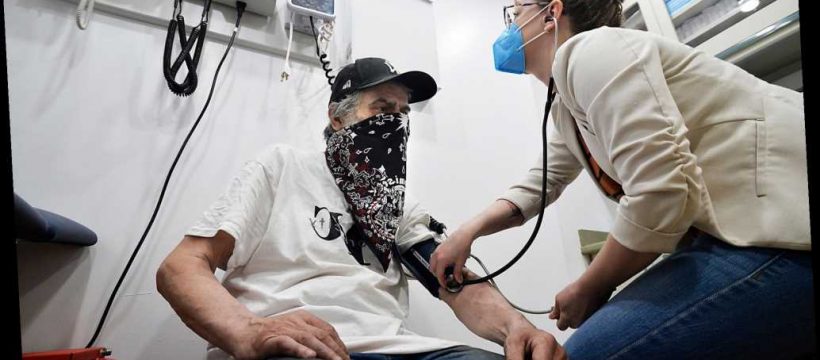Emily Gerteis is a nurse practitioner, but she’s not toiling away at Big Apple hospitals — she’s a primary care medical provider for homeless New Yorkers.
“It really is a crisis within a crisis,” Gerteis, 34, told The Post of how the pandemic has compounded the city’s enormous homeless dilemma.
“They don’t have access to stay at home. They don’t have a home, so they do not have that privilege to self-isolate, to quarantine themselves away from others. They don’t have access to bathrooms to wash their hands. They don’t have money for masks or gloves,” Gerteis, a medical director at the Center for Urban Community Services’ Janian Health, went on.
“They rely on folks to help work with them to get them housed and to get them off the street. And with essential staffing and things like that [cut during the crisis], they have less help these days, there’s less to be had, so they’re particularly at risk for getting ill and not being noticed.”
Early on in the crisis, Gerteis came down with what she’s sure was COVID-19 but she was unable to get tested, so she hunkered down and waited for the symptoms to subside while continuing to work from home.
“There was too much to do. There were too many things changing at that time … I couldn’t stop,” Gerteis, who lives in Bedford-Stuyvesant with her wife and two cats, explained.
“There’s no one to cover you, right, when you work in this type of work.”
By Monday, March 30, after a little over a week at home, Gerteis was already back at the Times Square Hotel where CUCS runs a supportive housing program for formerly homeless individuals with a history of mental illness or serious chronic health conditions.
“We have some high-risk staff that we had to pull from the field … I felt a big responsibility to my patients to return and to make sure that their health is managed,” Gerteis said of her decision to come back so quickly.
“It’s so amazing seeing all these [medical workers] coming back and you know, the military coming in to help the hospitals in New York City, but we know in our line of work that there’s no one that’s going to relieve us, so we have to keep going.”
Gerteis said she provides “typical family doctor services” — like getting patients to cardiology appointments, prescribing them medication, helping with wound care and counseling them on their diabetes.
She’s still doing that now — but with the “added twist” of dealing with her patient’s normal physical and mental illnesses and how they’re compounded with “a lot of anxiety” and “a lot of fear” that arose during the crisis.
“Whatever you’ve been dealing with day-to-day during normal life is being exacerbated right now,” Gerteis explained.
“So if you hear voices, the voices are definitely having an uptick. If you have anxiety and depression, those are getting worse. And you know, if you are easily kind of startled or easily quick to anger, those things are hard for you to handle right now.”
She said the underlying issue for most of the homeless she serves is “fear.” For many, it’s difficult to enter the shelter system but the pandemic has made it that much harder.
“They’re afraid that there is no safe place to go and the places that we normally create, right, these mental health shelters for people that have lived on the street for a year or more, right, they no longer feel safe at these places because of coronavirus,” Gerteis said.
While her work is difficult, Gerteis finds joy in tackling those tough issues. She described how she taught a patient who suffers from schizophrenia how to wear a mask properly, what the virus is all about and how they can keep themselves safe.
“People already have difficulties with their day-to-day living when they have a mental illness,” Gerteis said.
“So being able to be that resource, just being able to be there for folks in this time, to be someone to lean on, it’s amazing, it really is.”
Source: Read Full Article
